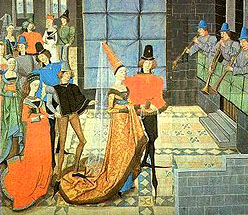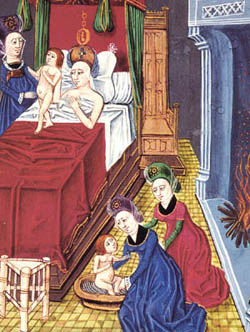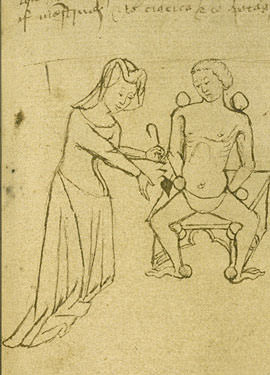Chapter VII. Napoleon in a Good Humor
The Emperor, though ill and discommoded on horseback by a local trouble, had never been in a better humor than on that day. His impenetrability had been smiling ever since the morning. On the 18th of June, that profound soul masked by marble beamed blindly. The man who had been gloomy at Austerlitz was gay at Waterloo. The greatest favorites of destiny make mistakes. Our joys are composed of shadow. The supreme smile is God's alone.
Ridet Caesar, Pompeius flebit, said the legionaries of the Fulminatrix Legion. Pompey was not destined to weep on that occasion, but it is certain that Caesar laughed. While exploring on horseback at one o'clock on the preceding night, in storm and rain, in company with Bertrand, the communes in the neighborhood of Rossomme, satisfied at the sight of the long line of the English camp-fires illuminating the whole horizon from Frischemont to Braine-l'Alleud, it had seemed to him that fate, to whom he had assigned a day on the field of Waterloo, was exact to the appointment; he stopped his horse, and remained for some time motionless, gazing at the lightning and listening to the thunder; and this fatalist was heard to cast into the darkness this mysterious saying, "We are in accord." Napoleon was mistaken. They were no longer in accord.
At half-past three o'clock in the morning, he lost one illusion; officers who had been despatched to reconnoitre announced to him that the enemy was not making any movement. Nothing was stirring; not a bivouac-fire had been extinguished; the English army was asleep. The silence on earth was profound; the only noise was in the heavens. At four o'clock, a peasant was brought in to him by the scouts; this peasant had served as guide to a brigade of English cavalry, probably Vivian's brigade, which was on its way to take up a position in the village of Ohain, at the extreme left. At five o'clock, two Belgian deserters reported to him that they had just quitted their regiment, and that the English army was ready for battle. "So much the better!" exclaimed Napoleon. "I prefer to overthrow them rather than to drive them back."
In the morning he dismounted in the mud on the slope which forms an angle with the Plancenoit road, had a kitchen table and a peasant's chair brought to him from the farm of Rossomme, seated himself, with a truss of straw for a carpet, and spread out on the table the chart of the battle-field, saying to Soult as he did so, "A pretty checker-board."
In consequence of the rains during the night, the transports of provisions, embedded in the soft roads, had not been able to arrive by morning; the soldiers had had no sleep; they were wet and fasting. This did not prevent Napoleon from exclaiming cheerfully to Ney, "We have ninety chances out of a hundred." At eight o'clock the Emperor's breakfast was brought to him. He invited many generals to it. During breakfast, it was said that Wellington had been to a ball two nights before, in Brussels, at the Duchess of Richmond's; and Soult, a rough man of war, with a face of an archbishop, said, "The ball takes place to-day." The Emperor jested with Ney, who said, "Wellington will not be so simple as to wait for Your Majesty." That was his way, however. "He was fond of jesting," says Fleury de Chaboulon. "A merry humor was at the foundation of his character," says Gourgaud. "He abounded in pleasantries, which were more peculiar than witty," says Benjamin Constant. These gayeties of a giant are worthy of insistence. It was he who called his grenadiers "his grumblers"; he pinched their ears; he pulled their mustaches. "The Emperor did nothing but play pranks on us," is the remark of one of them. During the mysterious trip from the island of Elba to France, on the 27th of February, on the open sea, the French brig of war, Le Zephyr, having encountered the brig L'Inconstant, on which Napoleon was concealed, and having asked the news of Napoleon from L'Inconstant, the Emperor, who still wore in his hat the white and amaranthine cockade sown with bees, which he had adopted at the isle of Elba, laughingly seized the speaking-trumpet, and answered for himself, "The Emperor is well." A man who laughs like that is on familiar terms with events. Napoleon indulged in many fits of this laughter during the breakfast at Waterloo. After breakfast he meditated for a quarter of an hour; then two generals seated themselves on the truss of straw, pen in hand and their paper on their knees, and the Emperor dictated to them the order of battle.
At nine o'clock, at the instant when the French army, ranged in echelons and set in motion in five columns, had deployed-- the divisions in two lines, the artillery between the brigades, the music at their head; as they beat the march, with rolls on the drums and the blasts of trumpets, mighty, vast, joyous, a sea of casques, of sabres, and of bayonets on the horizon, the Emperor was touched, and twice exclaimed, "Magnificent! Magnificent!"
Between nine o'clock and half-past ten the whole army, incredible as it may appear, had taken up its position and ranged itself in six lines, forming, to repeat the Emperor's expression, "the figure of six V's." A few moments after the formation of the battle-array, in the midst of that profound silence, like that which heralds the beginning of a storm, which precedes engagements, the Emperor tapped Haxo on the shoulder, as he beheld the three batteries of twelve-pounders, detached by his orders from the corps of Erlon, Reille, and Lobau, and destined to begin the action by taking Mont-Saint-Jean, which was situated at the intersection of the Nivelles and the Genappe roads, and said to him, "There are four and twenty handsome maids, General."
Sure of the issue, he encouraged with a smile, as they passed before him, the company of sappers of the first corps, which he had appointed to barricade Mont-Saint-Jean as soon as the village should be carried. All this serenity had been traversed by but a single word of haughty pity; perceiving on his left, at a spot where there now stands a large tomb, those admirable Scotch Grays, with their superb horses, massing themselves, he said, "It is a pity."
Then he mounted his horse, advanced beyond Rossomme, and selected for his post of observation a contracted elevation of turf to the right of the road from Genappe to Brussels, which was his second station during the battle. The third station, the one adopted at seven o'clock in the evening, between La Belle-Alliance and La Haie-Sainte, is formidable; it is a rather elevated knoll, which still exists, and behind which the guard was massed on a slope of the plain. Around this knoll the balls rebounded from the pavements of the road, up to Napoleon himself. As at Brienne, he had over his head the shriek of the bullets and of the heavy artillery. Mouldy cannon-balls, old sword-blades, and shapeless projectiles, eaten up with rust, were picked up at the spot where his horse' feet stood. Scabra rubigine. A few years ago, a shell of sixty pounds, still charged, and with its fuse broken off level with the bomb, was unearthed. It was at this last post that the Emperor said to his guide, Lacoste, a hostile and terrified peasant, who was attached to the saddle of a hussar, and who turned round at every discharge of canister and tried to hide behind Napoleon: "Fool, it is shameful! You'll get yourself killed with a ball in the back." He who writes these lines has himself found, in the friable soil of this knoll, on turning over the sand, the remains of the neck of a bomb, disintegrated, by the oxidization of six and forty years, and old fragments of iron which parted like elder-twigs between the fingers.
Every one is aware that the variously inclined undulations of the plains, where the engagement between Napoleon and Wellington took place, are no longer what they were on June 18, 1815. By taking from this mournful field the wherewithal to make a monument to it, its real relief has been taken away, and history, disconcerted, no longer finds her bearings there. It has been disfigured for the sake of glorifying it. Wellington, when he beheld Waterloo once more, two years later, exclaimed, "They have altered my field of battle!" Where the great pyramid of earth, surmounted by the lion, rises to-day, there was a hillock which descended in an easy slope towards the Nivelles road, but which was almost an escarpment on the side of the highway to Genappe. The elevation of this escarpment can still be measured by the height of the two knolls of the two great sepulchres which enclose the road from Genappe to Brussels: one, the English tomb, is on the left; the other, the German tomb, is on the right. There is no French tomb. The whole of that plain is a sepulchre for France. Thanks to the thousands upon thousands of cartloads of earth employed in the hillock one hundred and fifty feet in height and half a mile in circumference, the plateau of Mont-Saint-Jean is now accessible by an easy slope. On the day of battle, particularly on the side of La Haie-Sainte, it was abrupt and difficult of approach. The slope there is so steep that the English cannon could not see the farm, situated in the bottom of the valley, which was the centre of the combat. On the 18th of June, 1815, the rains had still farther increased this acclivity, the mud complicated the problem of the ascent, and the men not only slipped back, but stuck fast in the mire. Along the crest of the plateau ran a sort of trench whose presence it was impossible for the distant observer to divine.
What was this trench? Let us explain. Braine-l'Alleud is a Belgian village; Ohain is another. These villages, both of them concealed in curves of the landscape, are connected by a road about a league and a half in length, which traverses the plain along its undulating level, and often enters and buries itself in the hills like a furrow, which makes a ravine of this road in some places. In 1815, as at the present day, this road cut the crest of the plateau of Mont-Saint-Jean between the two highways from Genappe and Nivelles; only, it is now on a level with the plain; it was then a hollow way. Its two slopes have been appropriated for the monumental hillock. This road was, and still is, a trench throughout the greater portion of its course; a hollow trench, sometimes a dozen feet in depth, and whose banks, being too steep, crumbled away here and there, particularly in winter, under driving rains. Accidents happened here. The road was so narrow at the Braine-l'Alleud entrance that a passer-by was crushed by a cart, as is proved by a stone cross which stands near the cemetery, and which gives the name of the dead, Monsieur Bernard Debrye, Merchant of Brussels, and the date of the accident, February, 1637.[8] It was so deep on the table-land of Mont-Saint-Jean that a peasant, Mathieu Nicaise, was crushed there, in 1783, by a slide from the slope, as is stated on another stone cross, the top of which has disappeared in the process of clearing the ground, but whose overturned pedestal is still visible on the grassy slope to the left of the highway between La Haie-Sainte and the farm of Mont-Saint-Jean.
[8] This is the inscription:--
What was this trench? Let us explain. Braine-l'Alleud is a Belgian village; Ohain is another. These villages, both of them concealed in curves of the landscape, are connected by a road about a league and a half in length, which traverses the plain along its undulating level, and often enters and buries itself in the hills like a furrow, which makes a ravine of this road in some places. In 1815, as at the present day, this road cut the crest of the plateau of Mont-Saint-Jean between the two highways from Genappe and Nivelles; only, it is now on a level with the plain; it was then a hollow way. Its two slopes have been appropriated for the monumental hillock. This road was, and still is, a trench throughout the greater portion of its course; a hollow trench, sometimes a dozen feet in depth, and whose banks, being too steep, crumbled away here and there, particularly in winter, under driving rains. Accidents happened here. The road was so narrow at the Braine-l'Alleud entrance that a passer-by was crushed by a cart, as is proved by a stone cross which stands near the cemetery, and which gives the name of the dead, Monsieur Bernard Debrye, Merchant of Brussels, and the date of the accident, February, 1637.[8] It was so deep on the table-land of Mont-Saint-Jean that a peasant, Mathieu Nicaise, was crushed there, in 1783, by a slide from the slope, as is stated on another stone cross, the top of which has disappeared in the process of clearing the ground, but whose overturned pedestal is still visible on the grassy slope to the left of the highway between La Haie-Sainte and the farm of Mont-Saint-Jean.
[8] This is the inscription:--
D. O. M.
CY A ETE ECRASE
PAR MALHEUR
SOUS UN CHARIOT,
MONSIEUR BERNARD
DE BRYE MARCHAND
A BRUXELLE LE [Illegible]
FEVRIER 1637.
On the day of battle, this hollow road whose existence was in no way indicated, bordering the crest of Mont-Saint-Jean, a trench at the summit of the escarpment, a rut concealed in the soil, was invisible; that is to say, terrible.
















